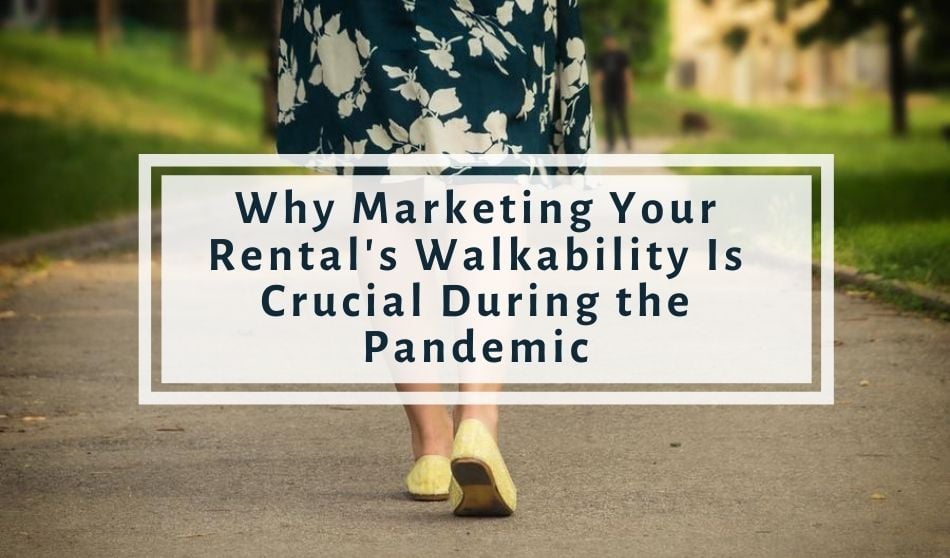
Walkability–the measure of how friendly an area is to walking, including the presence of pathways and sidewalks, user enjoyment, safety, and proximity to area amenities like schools, parks, restaurants, and shops–has always been an asset for rental properties.
After all, there is a reason for the existence of the real estate mantra “location, location, location.” Having a property in a good neighborhood that is within walking distance of key areas of interest can be the golden goose of any portfolio.
Now, as social distancing regulations make public transportation options limited or simply a less favorable option, the focus on a walkable apartment could be even higher on your applicants’ list of favorite features.
Walkability and Bikeability Needs Have Increased Due to COVID-19
Time Magazine reported that public transportation has been ‘apocalyptic’ as busses limit capacity to ensure social distancing measures are taking place. Alongside these capacity-limiting measures, some renters may simply feel more comfortable remaining out-of-doors for the duration of their travel for errands and entertainment. Now is the time to truly highlight the walkability of your rental.
Pre-pandemic, living in a walkable area was an already-high wishlist item. A survey released in 2013 by the National Association of Realtors, brought walkability to the forefront of real estate conversations. Results concluded that square footage is important to both homeowners and renters, but most were willing to compromise on the size of the home to be in a nice neighborhood and reduce the commute to work. The report indicated that an ideal neighborhood would include houses, shops, schools, and businesses.
Walkability may be more important now than ever. There is no doubt that as habits change to include more walking and biking, a rental in a walkable area will stay high on potential tenants’ wishlists long-term.
Why Potential Tenants Value a Walkability in a Rental Property
Beyond the needs created through the new lifestyle of the pandemic, renters see a lot of benefits from living in a walkable area. As Millennials and Gen Z, become key contributors in the housing and rental market, their awareness for healthy living, a cleaner environment, and a limited expendable income may contribute to the resurgence of walkable neighborhoods.
When you consider the advantages of living in a walkable neighborhood, it’s understandable that this feature is highly sought-after and why homes in walkable neighborhoods have higher rents and lower vacancies.
- It’s convenient: Tenants don’t have to go far to enjoy a great meal or take the kids to the park. No more getting stuck in traffic or having to search for parking. The commute to work could be reduced.
- It’s better for the Environment: With the green initiative and awareness on the rise “green” modes of transportation have become increasingly popular. Sustainable practices and living a lifestyle that minimizing pollutants is a high priority for a large portion of younger renters, millennial, and Gen Z renters.
- Additional Savings: Fewer trips to the gas station and less wear and tear on vehicles can translate to big savings.
- Closer-Knit Communities: Once social distancing measures are able to safely be reduced, a walkable neighborhood can encourage a sense of community. Being out-and-about with your fellow neighbors creates opportunities to develop friendships and a sense of belonging locally.
- Health Considerations: Sitting has been labeled the new smoking. As sedentary workers seek to add more movement to their day, a walkable neighborhood can translate to an easy way for health-conscious applicants to add much-needed exercise to their day.
How to Market Your Rental Property’s Walkability
The simplest and most precise way to highlight your property’s walkability is to add your property’s Walk Score to your rental listings. This online tool takes metrics like your unit’s distance from top areas of interest including restaurants, parks, libraries, shopping centers, schools, and more. Your address’s location in relation to these attractions is used to calculate your walk score; the higher the score the more walkable the neighborhood. The site lists an additional score is listed for likeability. You will even be provided with information about nearby attractions that can help you highlight the positive attributes of your property. The best part? Walk Score’s supporting research notes that a higher walk score can lead to higher housing prices, which is great news for rental property owners who want to maximize their rental income.
What to List If Your Walk Score is Unfavorable or Only Moderate
If your walk score is not high enough to list, be sure to highlight any significant locations or businesses that are within walking distance of your property. You may not have the most walkable property on the market, but potential tenants will still find value in a nearby store for grocery shopping or an-easy-to-reach park for their pets or children.
As a landlord, you can highlight the benefits of your rental property’s walkability to potential tenants. A high walkability helps your tenants meet their new year’s fitness goals. Your tenants will save money on gas and vehicle maintenance by keeping the car in park and opting to walk instead of drive. And they can contribute towards a cleaner environment by minimizing pollutants associated with driving. Providing this information to prospective tenants will help you fill vacancies faster, decrease vacancies, and increase market rent values.






Trackbacks/Pingbacks